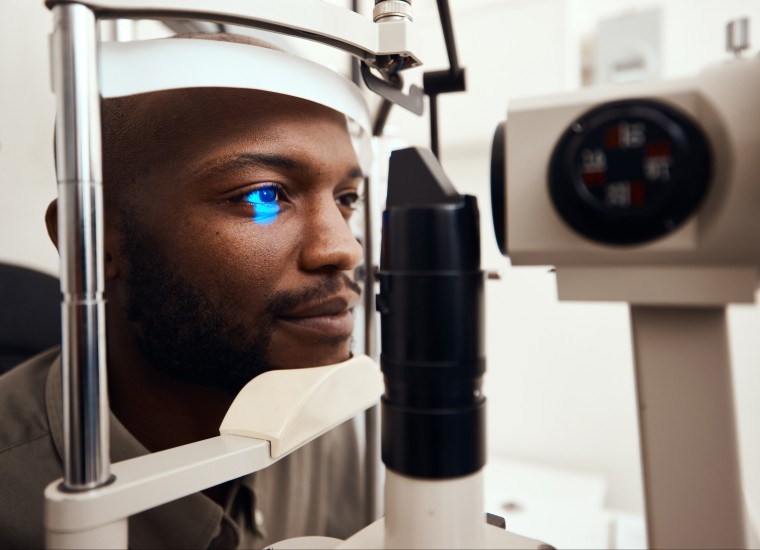The Comprehensive Eye Exam: What to Anticipate During Your Visit to the Eye Doctor
A visit to the eye physician for an extensive eye examination is more than a routine examination; it is an essential action in safeguarding your visual wellness. From the initial conversation of your medical history to the accuracy of the aesthetic acuity test, each component of the examination serves a certain purpose. However what exactly occurs during the eye health analysis, and just how does it influence the prescription process? Understanding these aspects is crucial for those that desire to preserve optimum sight. As we explore each component, the significance of follow-up referrals will certainly likewise end up being clear.
First Assessment
The preliminary assessment throughout an eye examination works as an important foundation for recognizing an individual's visual health needs. This phase sets the tone for the entire assessment process, permitting the eye doctor to gather vital information about the client's clinical background, way of life, and particular vision worries. By carefully examining any type of pre-existing conditions, medications, or previous surgeries, the eye care expert can tailor the assessment to attend to private needs successfully.

Moreover, the first consultation is a chance for people to voice any kind of problems or concerns, promoting a joint relationship with their doctor. This communication not only makes certain that the person feels notified and comfortable however also equips them to participate proactively in their eye health administration. Collectively, these conversations enable the eye doctor to devise a customized examination plan, making certain optimal treatment and exact diagnosis.
Aesthetic Acuity Test
Starting the core components of an eye exam, the visual acuity test is created to analyze the sharpness and clarity of a client's vision. This vital examination assists establish exactly how well an individual can discern letters or icons at a standardized range, generally making use of a Snellen graph (Eye Doctor). The graph makes up rows of letters that decrease in dimension inside out, with the person positioned at a customary range of 20 feet
Throughout the examination, the person is asked to cover one eye and check out aloud the smallest line of letters they can see clearly. This process is repeated for the various other eye. The outcomes are taped as a fraction, with 20/20 vision showing normal aesthetic acuity-- where the client can see at 20 feet what a person with regular vision can see at that distance.
The visual skill test also determines possible refractive mistakes such as astigmatism, hyperopia, or nearsightedness, which might require rehabilitative lenses. By developing a standard of aesthetic performance, the test is an essential diagnostic tool that assists the eye treatment professional in creating a proper therapy strategy customized to the individual's one-of-a-kind visual requirements.
Eye Wellness Evaluation
Complying with the aesthetic acuity test, a comprehensive eye health assessment is carried out to guarantee the general well-being of the eyes. This essential sector of the eye test entails an extensive analysis of both the exterior and inner structures of the eye. The ophthalmologist or optometrist begins by checking out the eyelids, cornea, conjunctiva, and sclera for any kind of indicators of infection, swelling, or problems. Utilizing specialized tools like a slit light, the specialist obtains a multiplied sight of the eye's makeup, allowing detailed inspection.
Following, focus shifts to the inner structures. Through using ophthalmoscopy or fundus digital photography, the retina, optic nerve, and capillary page are diligently examined. This action is vital for determining problems such as retinal detachment, glaucoma, or diabetic retinopathy. In a lot of cases, pupil extension is performed to boost exposure of the inner eye structures, although this might cause temporary light level of sensitivity for the patient.
Furthermore, intraocular pressure is measured to screen for glaucoma danger. This is generally done making use of tonometry, which can identify raised pressure levels that could suggest prospective damage to the optic nerve. Collectively, these analyses develop a detailed evaluation to keep eye wellness.
Refraction and Prescription
How does one make certain ideal vision? A vital action depends on the procedure of refraction and obtaining a precise prescription. Refraction is an innovative treatment performed by eye treatment specialists to determine the precise lens power required to remedy refractive mistakes such as nearsightedness, presbyopia, hyperopia, and astigmatism. The goal of this treatment is to assess just how light bends as it travels through the eye, allowing the practitioner to figure out whether restorative lenses are needed for enhanced visual acuity.
Throughout the refraction process, the person is asked to look via a phoropter, a gadget that includes numerous lenses. The professional will methodically alter these lenses and ask the patient to contrast clearness in between choices until the very best feasible vision is accomplished. This procedure is crucial in crafting an accurate prescription that defines the ideal lens power for spectacles or call lenses.
The prescription originated from this treatment not just enhances vision however likewise works as a structure for picking ideal corrective eyewear. It is vital to make sure that prescriptions are regularly upgraded, as modifications in vision can take place in time, emphasizing the relevance of regular eye exams. This careful focus to detail aids preserve clear, comfy vision in day-to-day live.
Follow-Up Referrals

During a follow-up see, the eye physician will certainly carry out a collection of examinations to review visual acuity and check for any changes in vision that might necessitate an update to the prescription. Additionally, the follow-up provides an opportunity to discuss any kind of pain or issues experienced with present glasses. Changes can be made to ensure comfort and efficacy, whether with lens alteration or structure changes.
For patients with ongoing conditions such as glaucoma, diabetes-related eye problems, or macular degeneration, more frequent follow-ups may be essential. These appointments are essential for handling and possibly slowing down the development of eye illness. Sticking to these suggestions can dramatically add to preserving aesthetic health and wellness and stopping long-lasting issues.
Final Thought
The extensive eye test is an important procedure for preserving aesthetic health and wellness, encompassing a detailed assessment of case history and vision concerns. Trick components my website include the aesthetic skill test, which examines sight clarity, and the eye health and wellness assessment, which takes a look at the overall condition of the eyes. Refraction examinations help establish the accurate lens prescription necessary for ideal vision correction. Follow-up referrals offer guidance for continuous eye treatment, making sure that any kind of prospective problems are attended to quickly and effectively.
A browse through to the eye doctor for a thorough eye exam is more than a routine check-up; it is a crucial action in protecting your visual health.Kicking off the core elements of an eye examination, the visual acuity examination is designed to analyze the sharpness and clearness of a client's vision.Adhering to the aesthetic skill test, an extensive eye health and wellness assessment is conducted to make sure the total well-being of the eyes. These brows through permit the eye care professional to check adjustments in vision, upgrade prescriptions, and analyze the total health and wellness of the eyes. Key components consist of the visual skill examination, which assesses sight clearness, and the eye health and wellness assessment, which checks out the general condition of the eyes.